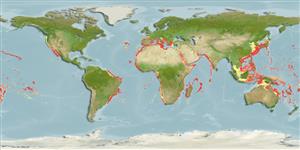Common names from other countries
Classification / Names / Names
Namen | Synonyme | Catalog of Fishes (gen., sp.) | ITIS | CoL | WoRMS
Environment: milieu / climate zone / depth range / distribution range
Ökologie
; tiefenbereich 50 - 850 m (Ref. 881). Tropical; 46°N - 23°S, 119°E - 56°E
Indo-Pacific, Atlantic Ocean and the Mediterranean: from Taiwan to New Caledonia, north to Italy and east to Reunion Island. Tropical and subtropical.
Length at first maturity / Size / Gewicht / Alter
Maturity: Lm 1.8 range ? - ? cm Max length : 3.4 cm CL Männchen/unbestimmt; (Ref. 106434); 4 cm CL (female)
Maximum depth from Ref. 97531. Maximum length based on occurrence (Ref. 106434); to be replaced with a better reference.
Members of the order Decapoda are mostly gonochoric. Mating behavior: Precopulatory courtship ritual is common (through olfactory and tactile cues); usually indirect sperm transfer.
Pinho, M.R., J.M. Gonçalves, H.R. Martins and G.M. Menezes. 2001. (Ref. 2747)
IUCN Rote Liste Status (Ref. 130435: Version 2024-1)
CITES Status (Ref. 108899)
Not Evaluated
Not Evaluated
Nutzung durch Menschen
Fischereien: kommerziell
| FishSource |
Tools
Internet Quellen
Estimates based on models
Preferred temperature
(Ref.
115969): 8.8 - 21.2, mean 14.2 (based on 536 cells).
Widerstandsfähigkeit
hoch, Verdopplung der Population dauert weniger als 15 Monate. (K=0.65-0.84; tm=1.5).
Verwundbarkeit
Low vulnerability (15 of 100).
